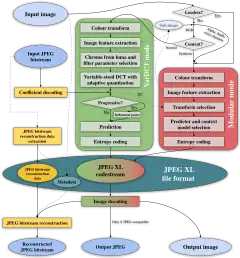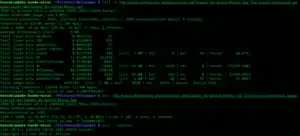JPEG XL
JPEG XL is a royalty-free raster-graphics file format that supports both lossy and lossless compression. It is designed to outperform existing raster formats and thus to become their universal replacement.[2]
 | |
| Filename extension |
.jxl |
|---|---|
| Internet media type |
image/jxl |
| Magic number | FF 0A or 00 00 00 0C 4A 58 4C 20 0D 0A 87 0A |
| Developed by | |
| Type of format | Lossy/lossless bitmap image format |
| Extended from | |
| Standard | ISO/IEC 18181 |
| Open format? | Yes (royalty-free) |
| Website |
|
Name
- JPEG is the Joint Photographic Experts Group, which is the committee that designed the format.
- X is part of the name of several JPEG standards since 2000: JPEG XT, JPEG XR, JPEG XS.
- L means Long-term because the authors' intention for the format is to replace the legacy JPEG and last as long too.[3]
Features
- Improved functionality and efficiency compared to traditional image formats (e.g. JPEG, GIF and PNG);
- Image dimensions of over a billion (230−1) pixels on each side;[6]
- Up to 4099 channels: 1 grayscale or 3 RGB channels, and optionally up to 4096 "extra" channels like alpha, depth or thermal data;[6]
- Progressive decoding (by resolution and precision);
- Lossless JPEG transcoding with ~20% size reduction;
- Lossless encoding and lossless alpha encoding;
- Support for both photographic and synthetic imagery;
- Graceful quality degradation across a large range of bitrates;
- Perceptually optimized reference encoder;
- Support for wide color gamut and HDR;
- Support for animated content,
- Efficient encoding and decoding without requiring specialized hardware
- In particular, JPEG XL is about as fast to encode and decode as old JPEG using libjpeg-turbo and an order of magnitude faster to encode and decode compared to HEIC with x265.[6] It is also parallelizable.
- Royalty-free format with an open-source reference implementation.[9]
Technical details

JPEG XL is based on ideas from Google's PIK format and Cloudinary's FUIF format (which was in turn based on FLIF).[10]
The format is mainly based on two encoding modes:
- VarDCT (variable-blocksize DCT) – utilizes the same DCT algorithm as legacy JPEG, but blocks instead of being restricted to 8x8 come in various sizes (2x2 up to 256x256), non-square shapes (e.g. 16x8, 8x32, 32x64) or can use another transforms (AFV, Hornuss).
- Modular – responsible, among others, for efficient lossless content encoding. This is the mode used for saving adaptive quantization fields, additional channels (e.g. alpha, depth, thermal, spot colors etc.) and DC coefficients (1:8 downsampled image) of the VarDCT mode. It also allows lossy compression with the help of modified Haar transform (called "squeeze"), which has progressive properties: the quality of the image increases with the amount of data loaded. One of the ways VarDCT-based images can be loaded progressively is by saving VarDCT's DC coefficients with Modular's "squeeze", making both modes work in tandem.
Both modes can be assisted by separate modeling of specific image features, unknown in other codecs at the time of creating the format:[lower-alpha 1]
- splines for coding e.g. hairs,
- repeating "patches" like text, dots or sprites,
- noise synthesis (since noise is hard to encode in both main modes, it's better to estimate its value in the encoder, save it, and then regenerate the noise in the decoder).
Lossy modes typically use the XYB color space derived from LMS.[12]
JPEG XL can losslessly reencode existing JPEG files by directly copying JPEG's DCT block coefficients to 8x8 VarDCT blocks, making smaller filesizes possible due to better entropy coding. JPEG reconstruction data allows transcoding back to the original JPEG file, although constraints limit support for some files.[13]
Prediction is run using a pixel-by-pixel decorrelator without side information, including a parametrized self-correcting weighted ensemble of predictors. Context modeling includes specialized static models and powerful meta-adaptive models that take local error into account, with a signaled tree structure and predictor selection per context. Entropy coding is LZ77-enabled and can use both asymmetric numeral systems (ANS) and Huffman coding (for low complexity encoders or for reducing overhead of short streams).
It defaults to a visually near-lossless setting that still provides good compression.[6]
Animated (multi-frame) images do not perform advanced inter-frame prediction, though some rudimentary inter-frame coding tools are available:
Software
Codec implementation
 | |
| Initial release | December 27, 2019 |
|---|---|
| Stable release | 0.6.1
/ October 30, 2021 |
| Repository | https://github.com/libjxl/libjxl[17] |
| Written in | C++ |
| Operating system | |
| License | New BSD License (previously Apache License 2.0) |
| Website | jpeg |
- JPEG XL Reference Software (libjxl)
- license: New BSD License (previously Apache License 2.0)
- contains (among others):
- coder
cjxl - decoder
djxl - fast lossless-only coder
fjxl - tool for benchmarking speed and quality of image codecs
benchmark_xl - GIMP and Gtk pixbuf plugin
file-jxl
- coder
Official support
- ImageMagick[18] – toolkit for raster graphics processing
- XnView MP[19] – viewer and editor of raster graphics
- gThumb[20] – image viewer for Linux
- IrfanView[21] – image viewer and editor for Windows
- ExifTool[22] – metadata editor
- libvips[23] – image processing library
- KaOS[24] – Linux distribution
- FFmpeg[25] – multimedia framework, via libjxl
- Qt / KDE apps[26] – via KImageFormats
Unofficial support
- Qt / KDE apps[27] – via plugin
- Microsoft Windows[28] – via WIC plugin, i.e. for viewing in Photo Viewer, File Explorer etc.
- macOS[29] – via standalone app and Quick Look plugin
- GIMP[3] – raster graphics editor; plugin for GIMP 2.10 available
Preliminary support
- Chromium[30] – web browser; in testing (as Chrome Beta and Edge Canary)
- Firefox[31] – web browser; in testing (as Firefox Nightly)
History
In 2017, JTC1/SC29/WG1 (JPEG) issued a call for proposals for JPEG XL – the next generation image coding standard.[32]
The file format (bitstream) was frozen on 25 December 2020[33] and formally standardized on 13 October 2021.[34] Any file compliant to this standard is guaranteed to be decodable by all future releases.
Standardization status
| Common Name | Part | First public release date (First edition) | ISO/IEC Number | Formal Title |
|---|---|---|---|---|
| JPEG XL | Part 1 | 30 March 2022 | ISO/IEC 18181-1 | JPEG XL Image Coding System — Part 1: Core coding system |
| Part 2 | 13 October 2021 | ISO/IEC 18181-2 | JPEG XL Image Coding System — Part 2: File format | |
| Part 3 | under development, planned for 2022 | ISO/IEC DIS 18181-3 | JPEG XL Image Coding System — Part 3: Conformance testing | |
| Part 4 | under development, planned for 2022 | ISO/IEC FDIS 18181-4 | JPEG XL Image Coding System — Part 4: Reference software |
References
- "fuif/README.md". GitHub. Archived from the original on 2021-04-24. Retrieved 2019-04-04.
- "Can JPEG XL Become the Next Free and Open Image Format? - Slashdot". Archived from the original on 2021-12-30. Retrieved 2021-02-20.
- "Support for reading/Writing JPEG XL images (#4681) · Issues · GNOME / GIMP". Archived from the original on 2021-12-30. Retrieved 2021-02-27.
- "JPEG XL reaches Committee Draft" (html). JPEG Org. 3 August 2019. Archived from the original on 3 August 2019. Retrieved 3 August 2019.
The current contributors have committed to releasing it publicly under a royalty-free and open source license.
- "JPEG XL White Paper" (PDF). JPEG Org. 22 January 2021. Archived (PDF) from the original on 2 May 2021. Retrieved 17 March 2021.
- Sneyers, Jon. "How JPEG XL Compares to Other Image Codecs". Cloudinary. Archived from the original on 2021-12-30. Retrieved 2021-02-19.
- Jon Sneyers (2021-01-03). "JPEG XL as PSD transfer/storage alternative". Reddit. Archived from the original on 2021-12-30. Retrieved 2021-06-07.
- Jon Sneyers (2021-06-03). "Progressive Transcoding". GitHub. Archived from the original on 2021-12-30. Retrieved 2021-06-07.
- "jpeg / JPEG XL Reference Software". GitLab. Archived from the original on 2021-12-30. Retrieved 2021-02-19.
- "FLIF - Free Lossless Image Format". Archived from the original on 2021-12-21. Retrieved 2021-04-06.
- Peter de Rivaz; Jack Haughton (2018). "AV1 Bitstream & Decoding Process Specification" (PDF). Alliance for Open Media. pp. 350–360. Retrieved 2022-01-15.
- Alakuijala, Jyrki; van Asseldonk, Ruud; Boukortt, Sami; Szabadka, Zoltan; Bruse, Martin; Comsa, Iulia-Maria; Firsching, Moritz; Fischbacher, Thomas; Kliuchnikov, Evgenii; Gomez, Sebastian; Obryk, Robert; Potempa, Krzysztof; Rhatushnyak, Alexander; Sneyers, Jon; Szabadka, Zoltan; Vandervenne, Lode; Versari, Luca; Wassenberg, Jan (6 September 2019). Tescher, Andrew G; Ebrahimi, Touradj (eds.). "JPEG XL next-generation image compression architecture and coding tools". Applications of Digital Image Processing XLII. 11137: 20. Bibcode:2019SPIE11137E..0KA. doi:10.1117/12.2529237. ISBN 9781510629677.
- Sneyers, Jon (2021-12-10). "Feature request: allow jbrd to reconstruct a part of the file when it's not possible for the whole file". GitHub.
- "JPEG XL reference implementation". GitHub. 3 December 2021. Archived from the original on 30 December 2021. Retrieved 24 June 2021.
- "JPEG XL reference implementation". GitHub. 3 December 2021. Archived from the original on 30 December 2021. Retrieved 24 June 2021.
- "JPEG XL reference implementation". GitHub. 3 December 2021. Archived from the original on 30 December 2021. Retrieved 24 June 2021.
- "PLEASE DO NOT OPEN NEW ISSUES HERE". Retrieved 27 May 2021.
- "ImageMagick". Archived from the original on 2022-01-02. Retrieved 2021-03-01.
- "0001845: JPEG XL - MantisBT". Archived from the original on 2021-11-07. Retrieved 2021-03-01.
- "GThumb Image Viewer 3.11.3 Adds JPEG XL (.JXL) Support [Ubuntu PPA] | UbuntuHandbook". Archived from the original on 2021-12-30. Retrieved 2021-05-17.
- "IrfanView PlugIns". Archived from the original on 2021-12-28. Retrieved 2021-12-03.
- "ExifTool by Phil Harvey". Retrieved 2022-01-19.
- "Release v8.11.0 · libvips/libvips · GitHub". Retrieved 2022-01-30.
- "KaOS 2021.06". Retrieved 2022-01-31.
- "FFmpeg Lands JPEG-XL Support". www.phoronix.com. Retrieved 2022-04-24.
- "KDE Ships Frameworks 5.89.0". KDE Community. 2021-12-11. Retrieved 2022-04-28.
- "Qt-jpegxl-image-plugin". GitHub. December 2021. Archived from the original on 2021-03-03. Retrieved 2021-03-01.
- "Jpeg Xl Wic". GitHub. 27 November 2021. Archived from the original on 30 December 2021. Retrieved 23 March 2021.
- "JXLook". GitHub. December 2021. Archived from the original on 2021-12-30. Retrieved 2021-03-01.
- "1178058 - chromium - an open-source project to help move the web forward. - Monorail". Archived from the original on 2021-12-30. Retrieved 2021-03-01.
- "1539075 - (JPEG-XL) Implement support for JPEG XL (Image/JXL)". Archived from the original on 2022-01-04. Retrieved 2021-03-01.
- "JPEG - Next-Generation Image Compression (JPEG XL) Final Draft Call for Proposals". Jpeg.org. April 23, 2018. Archived from the original on 30 December 2021. Retrieved 29 May 2018.
- "v0.2 JPEG XL Reference Software". GitLab. Archived from the original on 2021-10-20. Retrieved 2021-02-19.
- ISO/IEC 18181-2:2021 Information technology — JPEG XL image coding system — Part 2: File format
External links
| Wikimedia Commons has media related to JPEG XL. |
- Official website

- Reference implementation on GitHub
- builds:
- Nightly dev builds
- Windows Bin Builds (the page also contains many other programs)
- builds:
- Community website